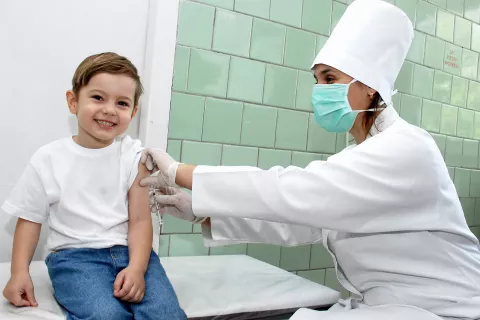Over 20 million children worldwide missed out on measles vaccine annually in past 8 years, creating a pathway to current global outbreaks - UNICEF

- Available in:
- English
- русский
NEW YORK, 25 April 2019 – An estimated 169 million children missed out on the first dose of the measles vaccine between 2010 and 2017, or 21.1 million children a year on average, UNICEF said today.
Widening pockets of unvaccinated children have created a pathway to the measles outbreaks hitting several countries around the world today.
“The ground for the global measles outbreaks we are witnessing today was laid years ago,” said Henrietta Fore, UNICEF Executive Director. “The measles virus will always find unvaccinated children. If we are serious about averting the spread of this dangerous but preventable disease, we need to vaccinate every child, in rich and poor countries alike.”
In the first three months of 2019, more than 110,000 measles cases were reported worldwide – up nearly 300 per cent from the same period last year. An estimated 110,000 people, most of them children, died from measles in 2017, a 22 per cent increase from the year before.
Two doses of the measles vaccine are essential to protect children from the disease. However, due to lack of access, poor health systems, complacency, and in some cases fear or skepticism about vaccines, the global coverage of the first dose of the measles vaccine was reported at 85 per cent in 2017, a figure that has remained relatively constant over the last decade despite population growth. Global coverage for the second dose is much lower, at 67 per cent. The World Health Organization recommends a threshold of 95 per cent immunization coverage to achieve so-called ‘herd immunity’.
|
1. United States: 2,593,000 |
|
2. France: 608,000 |
|
3. United Kingdom: 527,000 |
|
4. Argentina: 438,000 5. Italy: 435,000 |
|
6. Japan: 374,000 |
|
7. Canada: 287,000 |
|
8. Germany: 168,000 |
|
9. Australia: 138,000 |
|
10. Chile: 136,000 |
In high income countries, while coverage with the first dose is 94 per cent, coverage for the second dose drops to 91 per cent, according to the latest data.
The United States tops the list of high-income countries with the most children not receiving the first dose of the vaccine between 2010 and 2017, at more than 2.5 million. It is followed by France and the United Kingdom, with over 600,000 and 500,000 unvaccinated infants, respectively, during the same period.
In low- and middle-income countries, the situation is critical. In 2017, for example, Nigeria had the highest number of children under one year of age who missed out on the first dose, at nearly 4 million. It was followed by India (2.9 million), Pakistan and Indonesia (1.2 million each), and Ethiopia (1.1 million).
Worldwide coverage levels of the second dose of the measles vaccines are even more alarming. Of the top 20 countries with the largest number of unvaccinated children in 2017, 9 have not introduced the second dose. Twenty-countries in sub-Saharan Africa have not introduced the necessary second dose in the national vaccination schedule, putting over 17 million infants a year at higher risk of measles during their childhood.
UNICEF, with partners such as the Measles and Rubella Initiative and Gavi, the Vaccine Alliance, is helping address this measles crisis by:
- Negotiating vaccine prices: the cost of the measles vaccine is now at an all-time low;
- Helping countries identify underserved areas and unreached children;
- Procuring vaccines and other immunization supplies;
- Supporting supplementary vaccination campaigns to address gaps in routine immunization coverage;
- Working with relevant countries to introduce the second dose of the measles vaccine in the national immunization schedule. Cameroon, Liberia and Nigeria are on track to do so in 2019.
- Introducing innovations like the use of solar power and mobile technologies to maintain vaccines at the right temperature.
“Measles is far too contagious,” said Fore. “It is critical not only to increase coverage but also to sustain vaccination rates at the right doses to create an umbrella of immunity for everyone.”
######
Notes to editors
Download photos and broll here.
About the Analysis
The analysis is based on UNICEF and WHO’s estimation of national immunization coverage of 194 countries for 2017. Provisional measles and rubella data is based on monthly data reported to WHO Geneva in April 2019. For high income countries, follow the World Bank country classification by income in July 2018.
About World Immunization Week
Celebrated in the last week of April, World Immunization Week aims to promote the use of vaccines to protect people of all ages against disease. Find more details about UNICEF’s WIW efforts here.
About Measles and Rubella Initiative
UNICEF is part of the Measles and Rubella Initiative, a private-public partnership including WHO, CDC, United Nations Foundation and American Red Cross that spearheads a global push towards measles and rubella elimination and control.
Media contacts
About UNICEF
UNICEF promotes the rights and wellbeing of every child, in everything we do. Together with our partners, we work in 190 countries and territories to translate that commitment into practical action, focusing special effort on reaching the most vulnerable and excluded children, to the benefit of all children, everywhere.
For more information about UNICEF and its work for children, visit www.unicef.org.





